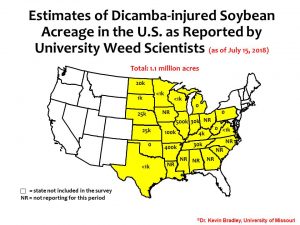As we have covered extensively here on Hygeia, the introduction of dicamba-tolerant soybeans in 2016 also triggered an unprecendented spike in herbicide-drift damage reports and associated litigation.
Millions of acres were damaged in 2016 and 2017 by drifting dicamba. Both the EPA and affected states established stricter rules in an effort to prevent further impacts. We detail this saga, and the generally feckless response to it by the EPA, in our Dicamba Watch dynamic presentation.
In the latest development, reported here by Delta Farm Press, the Weed Science Society of America has released a new report that summarizes the widespread problems with off-target drift of dicamba across the Midwest and Midsouth in 2016 and 2017.
One highlight of this report is a series of suggested actions and research areas that emerged from a regional panel of experts:
- Better tracking is needed of the types of crops and numbers of acres planted to dicamba-resistant varieties;
- Better records are needed on the terrain and weather conditions in areas where damage occurs;
- Address problems with herbicide labels, including the following recommendations from the Executive Summary – “1) lack of uniformity in label organization; 2) difficulty in finding and interpreting use instructions; 3) names of dicamba sensitive crops, landscape and native plants, and trees; 4) “neighboring distance” for sensitive crops; 5) descriptions of conditions leading to atmospheric inversions to protect applicators and neighbors (Source)”;
- Applicator training needs to be better coordinated; and
- Additional research is needed on the volatility of the new formulations, and on how dicamba moves around and damages crops
Meanwhile, the latest drift-damage estimates from 2018 have been released by Dr. Kevin Bradley, University of Missouri Division of Plant Sciences. Bradley has been compiling national numbers since the crisis began and is one of the most respected, independent weed scientists trying to help farmers, the ag industry, and regulators find a less costly way to deal with the spread of glyphosate-resistant weeds.

The map above summarizes the latest data. An estimated 1.1 million acres of soybeans alone have already been damaged by drifting dicamba. Illinois, Arkansas, and Missouri are by far the hardest hit by this crisis, now in it’s third year.
In 2017, about 20 million acres were planted to Extendimax soybeans, so about 60 million acres of soybeans were susceptible to dicamba drift and damage.
In 2018, about 40 million acres were planted to Extendimax beans, and another 40 million were not. Accordingly, the absolute number that is vulnerable and likely to be impacted is down, but the damage, when it occurs, could be more significant because so many more acres are being sprayed with dicamba.
Also, scientists are already reporting drift and damage to many more acres of trees and specialty crops, a trend bound to continue as the acreage planted to dicamba-resistant soybeans, cotton, corn and perhaps other crops increases in the years ahead.
And on top of dicamba drift and damage, rural residents across the Midwest will experience their first taste of 2,4-D drift and damage, as a result of the the first large-scale, commercial planting of 2,4-D resistant crops in crop year 2018.
Sources:
Bradley, Kevin, “July 15 Dicamba injury update. Different Year, same questions,” Integrated Pest Management, University of Missouri, July 19, 2018.
David Bennett, “Suspected Mid-South dicamba drift cases picking up,” Delta Farm Press, June 26, 2018.

